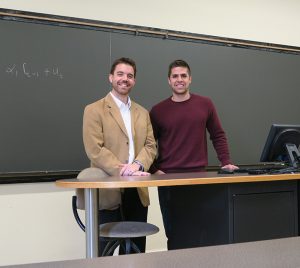
(l-r) Dr. Michael Aguilar and Gonzalo Asis
Education researchers know that experimentation and practical experience are important aspects of the learning process for many students. UNC Economics believes it as well, but our academic setting has made it hard for us to incorporate practical application into our on-campus courses.
This year we’ve introduced an innovation for our courses in the economics of financial markets. We’ve created a three-course sequence that will include not only the study of the theory and history of financial-market activity, but also practical applications of the theory to a host of market-related outcomes. With the generous funding of the Nasdaq Educational Foundation, we have created the template for a truly hands-on learning experience. Students completing the sequence will learn both the theoretical knowledge of financial markets and the practical experience of financial-market transactions.
What’s the innovation? Learning by doing.
- It is one thing to understand the theory of asset pricing, and another to incorporate that knowledge into bidding in a financial auction. Our students through participating in the bidding will deepen their understanding of asset pricing.
- Learning the theory of Federal-Reserve use of interest-rate targeting is only the beginning to understanding the connection of monetary policy and the real economy. Experimenting with quantitative modeling techniques provides the depth of understanding crucial to any financial market analyst.We have a dynamic team leading this innovation. Dr. Michael Aguilar is Senior Lecturer in Economics and the lead instructor for the credential. He has designed all three courses around active-learning strategies and has incorporated market simulations as a staple of the practical applications. He’s pleased with the opportunity to innovate in financial economics instruction:
“I’m an avid proponent of experiential education. There is no better way to understand a subject than learning-by-doing. That is precisely what we will do in this Credential. In every class session, students will be introduced to theory, and then put that theory into practice.”
“I often speak with prospective employers. They have always been impressed with the analytical skills of our Economics graduates, but often want more quantitative and practical experiences. The Credential is designed to fill this gap. We provide students with the computational and statistical tools necessary to bring the theory of financial economics to practice. In so doing, we complement the strong analytical foundation that is the hallmark of our economics program.”
Gonzalo Asis is the teaching assistant for the project and will be supervising the practicum. He brings a wealth of experience to this project, including spending the summer of 2016 as an intern at Tiger Management.
The Nasdaq Educational Foundation shared our vision and has provided a three-year grant to fund its implementation. In appreciation we will call this the Nasdaq Initiative for Quantitative Financial Economics. Students completing the three-course sequence will receive a credential from the Economics Department indicating their achievement.
We think this is an important and powerful approach to liberal-arts education. Incorporating practical exercises, quantitative simulations and creative experimentation will lead to better learning outcomes for most of our students. While we will demonstrate the value of the approach first for financial markets, we plan to extend it to other economic choices: health care, labor supply, industrial organization and consumer choice.
This photo is a message that Nasdaq broadcast on their tower in Times Square. The world is learning about us!
